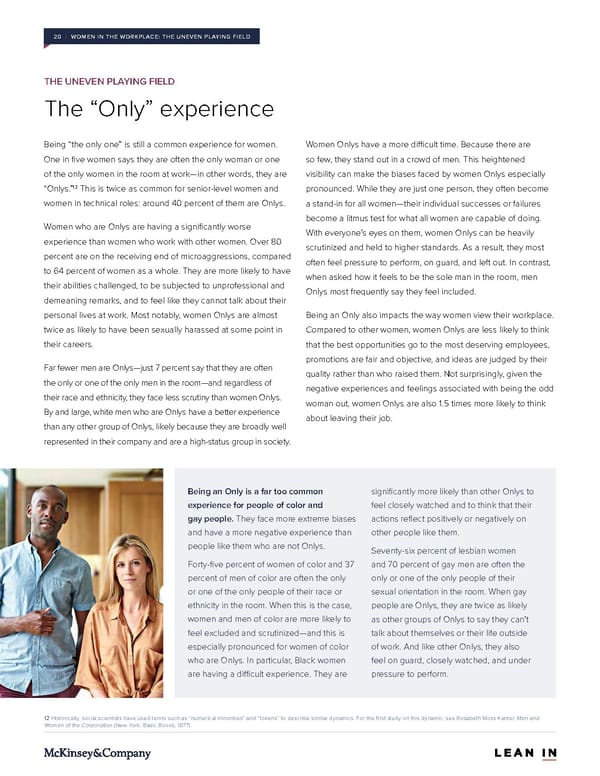20 | WOMEN IN THE WORKPLACE: THE UNEVEN PLAYING FIELD THE UNEVEN PLAYING FIELD The “Only” experience Being “the only one” is still a common experience for women. Women Onlys have a more difficult time. Because there are One in five women says they are often the only woman or one so few, they stand out in a crowd of men. This heightened of the only women in the room at work—in other words, they are visibility can make the biases faced by women Onlys especially 12 “Onlys.” This is twice as common for senior-level women and pronounced. While they are just one person, they often become women in technical roles: around 40 percent of them are Onlys. a stand-in for all women—their individual successes or failures become a litmus test for what all women are capable of doing. Women who are Onlys are having a significantly worse With everyone’s eyes on them, women Onlys can be heavily experience than women who work with other women. Over 80 scrutinized and held to higher standards. As a result, they most percent are on the receiving end of microaggressions, compared often feel pressure to perform, on guard, and left out. In contrast, to 64 percent of women as a whole. They are more likely to have when asked how it feels to be the sole man in the room, men their abilities challenged, to be subjected to unprofessional and Onlys most frequently say they feel included. demeaning remarks, and to feel like they cannot talk about their personal lives at work. Most notably, women Onlys are almost Being an Only also impacts the way women view their workplace. twice as likely to have been sexually harassed at some point in Compared to other women, women Onlys are less likely to think their careers. that the best opportunities go to the most deserving employees, promotions are fair and objective, and ideas are judged by their Far fewer men are Onlys—just 7 percent say that they are often quality rather than who raised them. Not surprisingly, given the the only or one of the only men in the room—and regardless of negative experiences and feelings associated with being the odd their race and ethnicity, they face less scrutiny than women Onlys. woman out, women Onlys are also 1.5 times more likely to think By and large, white men who are Onlys have a better experience about leaving their job. than any other group of Onlys, likely because they are broadly well represented in their company and are a high-status group in society. Being an Only is a far too common significantly more likely than other Onlys to experience for people of color and feel closely watched and to think that their gay people. They face more extreme biases actions reflect positively or negatively on and have a more negative experience than other people like them. people like them who are not Onlys. Seventy-six percent of lesbian women Forty-five percent of women of color and 37 and 70 percent of gay men are often the percent of men of color are often the only only or one of the only people of their or one of the only people of their race or sexual orientation in the room. When gay ethnicity in the room. When this is the case, people are Onlys, they are twice as likely women and men of color are more likely to as other groups of Onlys to say they can’t feel excluded and scrutinized—and this is talk about themselves or their life outside especially pronounced for women of color of work. And like other Onlys, they also who are Onlys. In particular, Black women feel on guard, closely watched, and under are having a difficult experience. They are pressure to perform. 12 Historically, social scientists have used terms such as “numerical minorities” and “tokens” to describe similar dynamics. For the first study on this dynamic, see Rosabeth Moss Kanter, Men and Women of the Corporation (New York: Basic Books, 1977).
 Women in the Workplace Page 25 Page 27
Women in the Workplace Page 25 Page 27